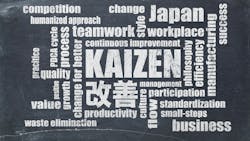Continuous improvement has become a must-have business mindset to innovate and stay ahead of competition. Working in manufacturing, you probably know kaizen— the Japanese word often translated as “continuous improvement” or “change for good.” It’s widely used in business operations, but too often, kaizen is seen only as a set of tools or a one-off “kaizen” event. You might not realize the deeper meaning of kaizen – and its potential for accelerating impact when integrated fully into everyday practices.
Kaizen is not just about improving processes, applying tools or holding a one-time improvement event. Kaizen is something you live and practice every day. It’s a mindset and a way of life, starting with yourself.
What Does Kaizen Really Mean?
When I moved to Japan a decade ago, I studied the language and discovered the true depth behind many words we commonly associate with lean manufacturing and the Toyota Production System. One of those words was kaizen.
I learned that the two kanji symbols making up kaizen—"Kai" and "Zen"—go far beyond simply "change" and "good."
The symbol “Kai” consists of two sub-symbols representing “self” and “whip.” “Self-whip” suggests discipline—starting with yourself and the willingness to look inward to make personal improvements.
The kanji representing “zen”—translated directly as “good” – represent two sub-symbols representing “sheep” and “altar,” or put together to mean “sacrifice”
When understood this way, the real essence of kaizen starts to reveal its true power. It’s the self-discipline to make sacrifices for the good—by letting go of and changing mindsets and behaviors that no longer serve you or your team. It’s about creating the habit to see every situation as a chance for improvement—for yourself, your teams, and the processes around you –to create better outcomes for the collective good.
I often play Devo’s song “Whip It” when sharing this deeper meaning of kaizen in keynote talks and leadership workshops. “Whipping it” is the self-discipline to improve yourself. As I explored in a previous IndustryWeek article, this means you have to have the discipline to forget everything you’ve learned about what leadership is about and create new habits better aligned with creating an organizational problem-solving culture.
Embedding Kaizen into Your Organization
As a leader or operational-excellence practitioner, one of the most powerful shifts you can make is moving from being the sole problem-solver to empowering others to solve problems.
In the song “Whip It,” the lyrics say, “When a problem comes along, you must whip it.”
When a challenge arises in your organization, do you “whip” the problem into shape or do you end up “whipping” the people involved? A culture of continuous improvement focuses on solving the problem, not blaming individuals. This is another example of the power of kaizen — whip the problem, not the person. This is the foundation of psychological safety.
And importantly, kaizen isn’t about you as the leader personally whipping all the problems that emerge in your organization – doing all the problem-solving yourself. The art of unburdened leadership is about you doing less and instead creating opportunities for others on your team to develop the capability and confidence for problem-solving. And this shift requires self-discipline.
When everyone adopts a kaizen mindset, you create a continuous loop of learning in your organization, where team members feel empowered to identify opportunities for improvement, collaborate on solutions and implement changes that move the organization forward. And it gives you the space to focus on other, broader organizational problems that need to be solved.
By enabling your people to solve problems, you foster a culture of collaboration and ownership—and that’s where true continuous improvement transformation happens.
How Can You Get Started with Daily Intentional Kaizen?
Here are practical steps to truly integrate kaizen into both your personal life and organizational culture:
- Lead by Example: Commit to self-improvement. Have the discipline to see your own opportunities for personal continuous improvement. Set daily intentions and practice each and every day to get better at creating a culture of improvement. By adopting a kaizen mindset and focusing on continuous growth, you set the tone for others to do the same.
- Create a Safe Environment for Experimentation: Encourage teams to try new ideas without the fear of failure or blame. Kaizen thrives where mistakes are seen as opportunities for learning.
- Foster Cross-Functional Collaboration: Break down barriers between departments and foster collaboration. Sharing ideas and knowledge creates better solutions.
- Make Kaizen a Daily Practice: Kaizen isn’t just a one-off event—it should be part of the daily routine. Small improvements everyday lead to big impact. Constant reflection and action are the key to a culture of continuous improvement.
When you embrace the real meaning of kaizen and embed it into your practices and your organization’s culture, it becomes a powerful force for long-term success. Start with yourself to make changes for the better today.
About the Author

Katie Anderson
Founder and Principal Consultant, Katie Anderson Consulting
Katie Anderson is an internationally recognized leadership consultant, speaker, and learning enthusiast best known for inspiring leaders to lead with intention to increase their impact. She is the author of the Shingo-award winning book "Learning to Lead, Leading to Learn," and the transformational change podcast, "Chain of Learning."
